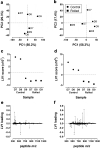Untargeted proteomics reveals upregulation of stress response pathways during CHO-based monoclonal antibody manufacturing process leading to disulfide bond reduction
- PMID: 34424810
- PMCID: PMC8386704
- DOI: 10.1080/19420862.2021.1963094
Untargeted proteomics reveals upregulation of stress response pathways during CHO-based monoclonal antibody manufacturing process leading to disulfide bond reduction
Abstract
Monoclonal antibody (mAb) interchain disulfide bond reduction can cause a loss of function and negatively impact the therapeutic's efficacy and safety. Disulfide bond reduction has been observed at various stages during the manufacturing process, including processing of the harvested material. The factors and mechanisms driving this phenomenon are not fully understood. In this study, we examined the host cell proteome as a potential factor affecting the susceptibility of a mAb to disulfide bond reduction in the harvested cell culture fluid (HCCF). We used untargeted liquid-chromatography-mass spectrometry-based proteomics experiments in conjunction with a semi-automated protein identification workflow to systematically compare Chinese hamster ovary (CHO) cell protein abundances between bioreactor conditions that result in reduction-susceptible and reduction-free HCCF. Although the growth profiles and antibody titers of these two bioreactor conditions were indistinguishable, we observed broad differences in host cell protein (HCP) expression. We found significant differences in the abundance of glycolytic enzymes, key protein reductases, and antioxidant defense enzymes. Multivariate analysis of the proteomics data determined that upregulation of stress-inducible endoplasmic reticulum (ER) and other chaperone proteins is a discriminatory characteristic of reduction-susceptible HCP profiles. Overall, these results suggest that stress response pathways activated during bioreactor culture increase the reduction-susceptibility of HCCF. Consequently, these pathways could be valuable targets for optimizing culture conditions to improve protein quality.
Keywords: CHO cell culture; Monoclonal antibody; cellular stress response; disulfide bond reduction; heat shock proteins; proteomics.
Conflict of interest statement
No potential conflict of interest was reported by the author(s).
Figures






Similar articles
-
Metabolic understanding of disulfide reduction during monoclonal antibody production.Appl Microbiol Biotechnol. 2020 Nov;104(22):9655-9669. doi: 10.1007/s00253-020-10916-1. Epub 2020 Sep 30. Appl Microbiol Biotechnol. 2020. PMID: 32997205
-
Air sparging for prevention of antibody disulfide bond reduction in harvested CHO cell culture fluid.Biotechnol Bioeng. 2015 Apr;112(4):734-42. doi: 10.1002/bit.25495. Epub 2014 Dec 23. Biotechnol Bioeng. 2015. PMID: 25384896
-
Quantitative proteomics reveals cellular responses to individual mAb expression and tunicamycin in CHO cells.Appl Microbiol Biotechnol. 2024 Jun 19;108(1):381. doi: 10.1007/s00253-024-13223-1. Appl Microbiol Biotechnol. 2024. PMID: 38896138 Free PMC article.
-
Antibody disulfide bond reduction and recovery during biopharmaceutical process development-A review.Biotechnol Bioeng. 2021 Aug;118(8):2829-2844. doi: 10.1002/bit.27790. Epub 2021 Jun 1. Biotechnol Bioeng. 2021. PMID: 33844277 Review.
-
Applications of proteomic methods for CHO host cell protein characterization in biopharmaceutical manufacturing.Curr Opin Biotechnol. 2018 Oct;53:144-150. doi: 10.1016/j.copbio.2018.01.004. Epub 2018 Feb 3. Curr Opin Biotechnol. 2018. PMID: 29414072 Review.
Cited by
-
New high-throughput screening method for Chinese hamster ovary cell lines expressing low reduced monoclonal antibody levels: application of a system controlling the gas phase over cell lysates in miniature bioreactors and facilitating multiple sample setup.Cytotechnology. 2023 Oct;75(5):421-433. doi: 10.1007/s10616-023-00587-x. Epub 2023 Jul 21. Cytotechnology. 2023. PMID: 37655271 Free PMC article.
-
Proteomics Reveals Distinctive Host Cell Protein Expression Patterns in Fed-Batch and Perfusion Cell Culture Processes.Biotechnol J. 2025 Jan;20(1):e202400567. doi: 10.1002/biot.202400567. Biotechnol J. 2025. PMID: 39834099 Free PMC article.
-
Recent Advances in Engineering the Unfolded Protein Response in Recombinant Chinese Hamster Ovary Cell Lines.Int J Mol Sci. 2025 Jul 25;26(15):7189. doi: 10.3390/ijms26157189. Int J Mol Sci. 2025. PMID: 40806322 Free PMC article. Review.
-
SWATH-MS insights on sodium butyrate effect on mAbs production and redox homeostasis in CHO cells.AMB Express. 2024 Dec 24;14(1):140. doi: 10.1186/s13568-024-01807-z. AMB Express. 2024. PMID: 39718710 Free PMC article.
-
Exploring metabolic effects of dipeptide feed media on CHO cell cultures by in silico model-guided flux analysis.Appl Microbiol Biotechnol. 2024 Dec;108(1):123. doi: 10.1007/s00253-023-12997-0. Epub 2024 Jan 16. Appl Microbiol Biotechnol. 2024. PMID: 38229404 Free PMC article.
References
-
- Lee H-W, Bhatia H, Park S-Y, Kamga M-H, Reimonn T, Sha S, Zhuangrong H, Galbraith S, Liu H, Yoon S.. Process analytical technology and quality by design for animal cell culture. In: Lee GM, Kildegaard HF, editors. Cell culture engineering: recombinant protein production. Weinheim (Germany): Wiley-VCH Verlag GmbH & Co. KGaA; 2019. p. 365–90. doi:10.1002/9783527811410.ch15. - DOI
-
- Morris C, Polanco A, Yongky A, Xu J, Huang Z, Zhao J, McFarland KS, Park S-Y, Warrack B, Reily M, et al. Big data analytics identifies metabolic inhibitors and promoters for productivity improvement and optimization of monoclonal antibody (mAb) production process. Bioresour Bioprocess. 2020;7(1):1–13. doi:10.1186/s40643-020-00318-6. - DOI
-
- Das TK, Narhi LO, Sreedhara A, Menzen T, Grapentin C, Chou DK, Antochshuk V, Filipe V. Stress factors in mAb drug substance production processes: critical assessment of impact on product quality and control strategy. J Pharm Sci. 2020;109(1):116–33. doi:10.1016/j.xphs.2019.09.023. PMID: 31593689. - DOI - PubMed
Publication types
MeSH terms
Substances
Grants and funding
LinkOut - more resources
Full Text Sources
Miscellaneous
